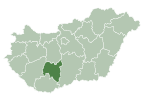|
Gyönk
Gyönk (German: Jink) is a village in Tolna County, Hungary. HistoryGyönk was mentioned for the first time in 1280, but the neighborhood (and Gyönk) was already a populated area by then. The village was inhabited by Turks for some time, and by the time of the Rákóczi it was depopulated. In the early 18th century, Hungarian and German families arrived in the village. The school was founded in 1806. In 1882, the Budapest-Pécs-Dombóvár-rail line, which passes through the Kapos Valley connected the village. In 1891, there were 3,371 German and Hungarian inhabitants. In 1947, a Czechoslovak-Hungarian population exchange saw 9 Highland Hungarian families (55 people) resettled in the upland village of Martos. Until the end of World War II, the inhabitants' majority was Danube Swabian (Schwowe), whose ancestors had come from Swabia and Franconia. Around 1790, Catholic German families from Gyönk settled in Illocska.[1] Most of the former German settlers were expelled to Allied-occupied Germany and Allied-occupied Austria in 1945–1948, following the Potsdam Agreement.[2] Only a few Germans of Hungary live there, the majority today are the descendants of Hungarians from the Czechoslovak–Hungarian population exchange. Notable landmarksThe Reformed Church was built between 1775 and 1777, and consecrated on May 25, 1777. The tower was completed in 1836. The second organ of the church, dated to 1910 is a masterpiece. The neo-Gothic style Lutheran Church designed by Gyula Reppmannin was completed in 1896. The Catholic Church was built in 1926. Magyary Kossa-Castle was built in 1830. DemographicsAs of 2022, the town is 91.7% Hungarian, 8.7% German, 2.8% Gypsy, and 1.1% of non-European origin. 27.7% of the townsfolk are Roman Catholic, 13.8% Lutheran, 13.1% Reformed, and 10.8% nondenominational.[3] Twin towns – sister citiesGyönk is twinned with:
References
|
||||||||||||||||||||||||||||||||||||||





